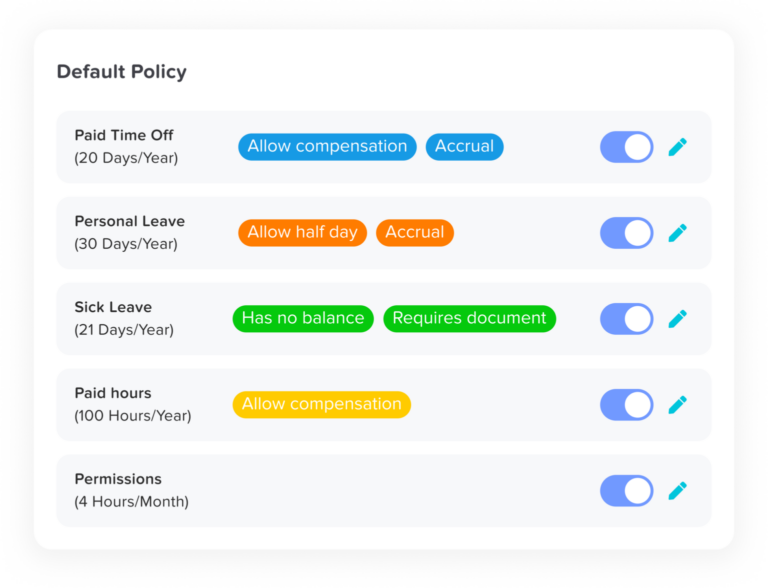Table of Contents
ToggleWhether you’re planning a vacation, attending a family event, or simply taking a day to recharge, time off request is part of maintaining a healthy work-life balance. But one common question arises across every workplace: “How far in advance should I request time off?”
Submitting your request too late can lead to scheduling conflicts, denied leave, or strained workplace relationships. On the flip side, planning ahead helps your manager and teammates prepare and shows professionalism on your part.
Why Timely Time Off Request Matter
1. Time Off Request Reduces Stress and Confusion
Planning ahead gives everyone yourself included time to adjust. When time off requests are submitted late, it can lead to rushed project deadlines, coverage gaps, or confusion about responsibilities. By giving proper notice, you reduce last-minute chaos and give your manager enough time to accommodate your absence without disrupting workflow.
2. Time Off Request Improves Team Coordination
Teamwork thrives on predictability. When your teammates and supervisors know who will be out and when, they can assign tasks accordingly, adjust meetings, and align deadlines. For example, if two team members submit time off requests for the same week, early planning helps resolve the conflict without tension or delays in team output.
3. Time Off Request Boosts Your Chances of Approval
Managers are more likely to approve requests that come in early especially during high-demand times like summer, year-end, or holiday seasons. Waiting until the last minute means you risk your request being denied due to staffing constraints or existing PTO overlaps.
4. Time Off Request Aligns With Company Policy
Many organizations have formal guidelines stating how far in advance requests should be submitted often 1–4 weeks. Failing to follow these rules can result in automatic rejection or unnecessary back-and-forth with HR. Understanding your workplace’s expectations is key to smooth approval.
Recommended Advance Notice by Leave Type
Here’s an in-depth look at common time off categories and suggested lead times:
Vacation Leave
Suggested Notice: 2–4 weeks (or more if during busy seasons)
Reason: Vacation time often spans several consecutive days and may involve travel bookings, making it harder to reschedule. For your team, longer absences require redistributing ongoing responsibilities, rescheduling client meetings, and possibly even shifting deadlines. The more notice you give, the more smoothly those transitions happen ensuring your break is stress-free.
Personal Days
Suggested Notice: 5–10 business days
Reason: Though usually only a day or two, personal days still affect your daily workload. Whether it’s a mental health day, family obligation, or a home repair appointment, your absence means someone else may need to step in. Giving at least a week’s notice helps your manager plan around it and shows respect for the team’s time.
Medical or Sick Leave
Suggested Notice: As early as possible (same-day if sudden)
Reason: While some medical leave is unplanned (like catching the flu), others like scheduled procedures or doctor’s appointments can and should be communicated in advance. Even if you’re unexpectedly sick, notifying your team promptly helps them arrange coverage or reschedule meetings. For longer medical leaves, submit documentation and timelines as early as you can.
Parental or Extended Leave
Suggested Notice: 30–90 days or more
Reason: Maternity, paternity, and long-term leaves often require legal paperwork, handoff planning, temporary replacements, and formal HR approval. These are major absences that affect the entire organization, so the earlier you begin the conversation, the better. In many cases, companies require 60 or 90 days’ notice for these leaves.
Emergency Leave or Bereavement
Suggested Notice: Notify as soon as possible
Reason: Life is unpredictable. In cases of death in the family, accidents, or crises, notifying your employer immediately even informally via a quick message helps them act quickly to support you and shift your workload. Many workplaces offer additional compassion leave or counseling resources.

Additional Considerations When Planning Ahead
Team Availability
Before choosing dates, check your team’s calendar or project timelines. If another teammate is already scheduled off during your preferred time, your request may not be feasible. Early coordination prevents conflicts and encourages fairness when multiple people are requesting similar days.
Seasonal Workload
Every industry has busy periods. Retailers experience year-end rushes, accountants face tax season, and customer support may be overloaded during product launches. Planning your leave around these cycles shows strategic thinking and helps maintain productivity during peak demand.
Fairness and First-Come, First-Served
Many workplaces handle overlapping time off requests on a first-come, first-served basis. Submitting yours early gives you an edge especially when requesting holidays, long weekends, or school vacation periods. Waiting could mean losing out to a colleague who asked earlier.
Manager Workload
Even your manager needs time off! If they’re also scheduled to be away, they may not be available to approve your request promptly. Aim to submit leave requests during normal planning cycles or when your supervisor is fully available to consider your dates.
Best Practices for Submitting Time Off Request
To improve your chances of approval and minimize disruptions:
Check Your PTO Balance
Before submitting a request, ensure you have enough available leave. Many companies let you track this via HR platforms or apps like Day Off. Submitting a request you can’t afford to take is a surefire way to delay approval.Follow Company Policy
Whether it’s submitting a form, logging into an HR portal, or emailing your supervisor, stick to the formal process. Bypassing procedure even for a casual day off can lead to misunderstandings.Include Full Details
List the exact dates and times you’ll be away, whether the leave is partial or full-day, and what type of leave it is (e.g., vacation, sick, personal). Clear communication eliminates guesswork for managers.Provide a Transition Plan
Propose how your duties will be handled during your absence. This might include drafting an out-of-office message, notifying clients in advance, or arranging for a teammate to cover key tasks.Avoid Last-Minute Requests (if possible)
Emergencies aside, try not to request time off with less than 24–48 hours’ notice. Short notice is disruptive and reduces your chances of approval.Confirm and Document Approval
Once approved, save confirmation emails or screenshots in case of disputes later. Some systems will auto-track this; if not, document it yourself.
Use Technology to Simplify the Process
Apps like Day Off help both employees and employers manage time off requests efficiently. With a few taps, you can submit a request, see who’s off, check your remaining balance, and get real-time approval.
Benefits of Using Day Off:
Submit requests from anywhere mobile or desktop
Get instant push notifications when approved
View coworkers’ planned absences to prevent overlaps
Sync with HR or calendar systems for better planning
Keep historical records of all past requests
Using a digital tool minimizes delays, reduces paperwork, and builds transparency across your team.
Industry Data That Backs It Up
60% of HR professionals report that late requests are the top cause of time off conflicts (SHRM 2024).
Teams using PTO management apps report 25–30% fewer last-minute absences, improving overall productivity.
Employees who take regular, pre-planned time off are 31% more engaged and less likely to experience burnout (Harvard Business Review, 2023).
FAQs
1. What if my company doesn’t have a formal time off policy?
If there’s no clear policy in place, aim to give at least two weeks’ notice for planned absences. For shorter personal days, one week is usually acceptable. Always communicate directly with your manager and offer to help plan around your absence. Document your request via email for clarity.
2. Can my manager deny a time off request even if I submit it early?
Yes. While early notice improves your chances, approval still depends on team availability, business needs, and company policies. For example, during high-demand periods or if your absence overlaps with another critical team member’s time off, your manager may ask you to adjust your dates.
3. Is it okay to take time off during a busy season?
It depends. If your absence won’t disrupt key deliverables or your team can manage the workload, it might still be approved. However, it’s best to avoid peak times unless your leave is urgent or pre-approved. Communicate with your manager early and offer solutions to cover your responsibilities.
4. Can I request time off through a mobile app like Day Off?
Absolutely. Apps like Day Off streamline the entire process. You can request leave, view your PTO balance, check team availability, and receive real-time approval notifications all from your phone or computer. This minimizes delays, improves tracking, and makes the process transparent for all parties involved.
5. How should I handle overlapping time off request with a teammate?
If you notice a potential conflict, speak with your colleague and manager early. Some teams rotate priority based on first-come, first-served, while others prioritize based on seniority or team roles. Being proactive and flexible increases the chance of finding a compromise.
6. Do I need to give a reason for my time off request?
In most cases, especially for vacation or personal time, you don’t need to provide detailed reasons. However, for medical leave, bereavement, or extended leave, documentation may be required by HR. If in doubt, check your company’s leave policy or speak with your manager.
7. What if I need to cancel or change my approved time off?
If your plans change, notify your manager or update your request in your leave management system (like Day Off) as soon as possible. The earlier you communicate the change, the easier it is to reassign work or update the team schedule.
8. Can I Time Off Request on short notice in emergencies?
Yes, most employers understand that emergencies happen. For unplanned sick leave, family emergencies, or sudden events, notify your manager as soon as possible, even if it’s a brief message. Follow up later with any required documentation if needed.
9. How far in advance should I Time Off Request during the holidays?
Holiday periods tend to be in high demand. Aim to submit holiday requests at least 4–6 weeks in advance or even earlier if your company uses a priority system. Planning early improves your chances and helps managers create fair holiday schedules.
10. Is there a limit to how many days off I can request at once?
That depends on your PTO balance and company policy. Some companies allow extended leave if coordinated properly, while others may cap consecutive days. Always confirm your available balance and speak with your manager if requesting more than a standard week.
